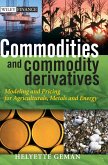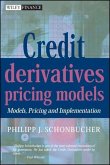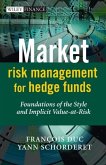Iain J. Clark
Foreign Exchange Option Pricing
Iain J. Clark
Foreign Exchange Option Pricing
- Gebundenes Buch
- Merkliste
- Auf die Merkliste
- Bewerten Bewerten
- Teilen
- Produkt teilen
- Produkterinnerung
- Produkterinnerung
This book covers foreign exchange options from the point of view of the finance practitioner. It contains everything a quant or trader working in a bank or hedge fund would need to know about the mathematics of foreign exchange--not just the theoretical mathematics covered in other books but also comprehensive coverage of implementation, pricing and calibration.
With content developed with input from traders and with examples using real-world data, this book introduces many of the more commonly requested products from FX options trading desks, together with the models that capture the risk…mehr
Andere Kunden interessierten sich auch für
![Commodities and Commodity Derivatives Commodities and Commodity Derivatives]() Heylette GemanCommodities and Commodity Derivatives119,99 €
Heylette GemanCommodities and Commodity Derivatives119,99 €![The Blank Swan The Blank Swan]() Elie AyacheThe Blank Swan62,99 €
Elie AyacheThe Blank Swan62,99 €![Credit Derivatives Pricing Models Credit Derivatives Pricing Models]() Philipp J. SchönbucherCredit Derivatives Pricing Models187,99 €
Philipp J. SchönbucherCredit Derivatives Pricing Models187,99 €![Counterparty Credit Risk, Collateral and Funding Counterparty Credit Risk, Collateral and Funding]() Damiano BrigoCounterparty Credit Risk, Collateral and Funding113,99 €
Damiano BrigoCounterparty Credit Risk, Collateral and Funding113,99 €![Structured Products Volume 2 Structured Products Volume 2]() Satyajit DasStructured Products Volume 2151,99 €
Satyajit DasStructured Products Volume 2151,99 €![Market Risk Management for Hedge Funds Market Risk Management for Hedge Funds]() Francois DucMarket Risk Management for Hedge Funds102,99 €
Francois DucMarket Risk Management for Hedge Funds102,99 €![A Guide to Starting Your Hedge Fund A Guide to Starting Your Hedge Fund]() John P. ThompsonA Guide to Starting Your Hedge Fund156,99 €
John P. ThompsonA Guide to Starting Your Hedge Fund156,99 €-
-
-
This book covers foreign exchange options from the point of view of the finance practitioner. It contains everything a quant or trader working in a bank or hedge fund would need to know about the mathematics of foreign exchange--not just the theoretical mathematics covered in other books but also comprehensive coverage of implementation, pricing and calibration.
With content developed with input from traders and with examples using real-world data, this book introduces many of the more commonly requested products from FX options trading desks, together with the models that capture the risk characteristics necessary to price these products accurately. Crucially, this book describes the numerical methods required for calibration of these models - an area often neglected in the literature, which is nevertheless of paramount importance in practice. Thorough treatment is given in one unified text to the following features:
Correct market conventions for FX volatility surface construction
Adjustment for settlement and delayed delivery of options
Pricing of vanillas and barrier options under the volatility smile
Barrier bending for limiting barrier discontinuity risk near expiry
Industry strength partial differential equations in one and several spatial variables using finite differences on nonuniform grids
Fourier transform methods for pricing European options using characteristic functions
Stochastic and local volatility models, and a mixed stochastic/local volatility model
Three-factor long-dated FX model
Numerical calibration techniques for all the models in this work
The augmented state variable approach for pricing strongly path-dependent options using either partial differential equations or Monte Carlo simulation
Connecting mathematically rigorous theory with practice, this is the essential guide to foreign exchange options in the context of the real financial marketplace.
Table of Contents
Mathematical Preliminaries
Deltas and Market Conventions
Volatility Surface Construction
Local Volatility and Implied Volatility
Stochastic Volatility
Numerical Methods for Pricing and Calibration
First Generation Exotics - Binary and Barrier Options
Second Generation Exotics
Multicurrency Options
Long-dated FX Options
Hinweis: Dieser Artikel kann nur an eine deutsche Lieferadresse ausgeliefert werden.
With content developed with input from traders and with examples using real-world data, this book introduces many of the more commonly requested products from FX options trading desks, together with the models that capture the risk characteristics necessary to price these products accurately. Crucially, this book describes the numerical methods required for calibration of these models - an area often neglected in the literature, which is nevertheless of paramount importance in practice. Thorough treatment is given in one unified text to the following features:
Correct market conventions for FX volatility surface construction
Adjustment for settlement and delayed delivery of options
Pricing of vanillas and barrier options under the volatility smile
Barrier bending for limiting barrier discontinuity risk near expiry
Industry strength partial differential equations in one and several spatial variables using finite differences on nonuniform grids
Fourier transform methods for pricing European options using characteristic functions
Stochastic and local volatility models, and a mixed stochastic/local volatility model
Three-factor long-dated FX model
Numerical calibration techniques for all the models in this work
The augmented state variable approach for pricing strongly path-dependent options using either partial differential equations or Monte Carlo simulation
Connecting mathematically rigorous theory with practice, this is the essential guide to foreign exchange options in the context of the real financial marketplace.
Table of Contents
Mathematical Preliminaries
Deltas and Market Conventions
Volatility Surface Construction
Local Volatility and Implied Volatility
Stochastic Volatility
Numerical Methods for Pricing and Calibration
First Generation Exotics - Binary and Barrier Options
Second Generation Exotics
Multicurrency Options
Long-dated FX Options
Hinweis: Dieser Artikel kann nur an eine deutsche Lieferadresse ausgeliefert werden.
Produktdetails
- Produktdetails
- Wiley Finance Series
- Verlag: Wiley & Sons
- Artikelnr. des Verlages: 14568368000
- 1. Auflage
- Seitenzahl: 304
- Erscheinungstermin: 26. November 2010
- Englisch
- Abmessung: 250mm x 175mm x 21mm
- Gewicht: 675g
- ISBN-13: 9780470683682
- ISBN-10: 0470683686
- Artikelnr.: 31302637
- Herstellerkennzeichnung
- Libri GmbH
- Europaallee 1
- 36244 Bad Hersfeld
- gpsr@libri.de
- Wiley Finance Series
- Verlag: Wiley & Sons
- Artikelnr. des Verlages: 14568368000
- 1. Auflage
- Seitenzahl: 304
- Erscheinungstermin: 26. November 2010
- Englisch
- Abmessung: 250mm x 175mm x 21mm
- Gewicht: 675g
- ISBN-13: 9780470683682
- ISBN-10: 0470683686
- Artikelnr.: 31302637
- Herstellerkennzeichnung
- Libri GmbH
- Europaallee 1
- 36244 Bad Hersfeld
- gpsr@libri.de
Dr Iain J. Clark, (London, UK), is Head of Foreign Exchange Quantitative Analysis at Dresdner Kleinwort in London, where he set up and runs the team responsible for developing pricing libraries for the front office. Previously, he was Director of the Quantitative Research Group in Lehman Brothers, Fixed Income Quantitative Analyst at BNP Paribas and has also worked in FX Commodities Derivatives research at JP Morgan. He holds an MSc in Mathematics from the University of Edinburgh, and a PhD in Applied Mathematics from the University of Queensland, Australia. Dr Clark is a regular speaker at key finance events, and has presented at London Imperial College, The Bachelier Society Annual Conference, London Imperial College, world business Strategies annual Conference, Risk events, Marcus Evans events and many more.
Acknowledgements xiii
List of Tables xv
List of Figures xvii
1 Introduction 1
1.1 A Gentle Introduction to FX Markets 1
1.2 Quotation Styles 2
1.3 Risk Considerations 5
1.4 Spot Settlement Rules 5
1.5 Expiry and Delivery Rules 8
1.5.1 Expiry and delivery rules - days or weeks 8
1.5.2 Expiry and delivery rules - months or years 9
1.6 Cutoff Times 10
2 Mathematical Preliminaries 13
2.1 The Black-Scholes Model 13
2.1.1 Assumptions of the Black-Scholes model 13
2.2 Risk Neutrality 13
2.3 Derivation of the Black-Scholes equation 14
2.3.1 Equity derivatives (without dividends) 14
2.3.2 FX derivatives 15
2.3.3 Terminal conditions and present value 17
2.4 Integrating the SDE for S T 17
2.5 Black-Scholes PDEs Expressed in Logspot 18
2.6 Feynman-Kac and Risk-Neutral Expectation 18
2.7 Risk Neutrality and the Presumption of Drift 20
2.7.1 Equity derivatives (without dividends) 20
2.7.2 FX derivatives - domestic risk-neutral measure 21
2.7.3 FX derivatives - foreign risk-neutral measure 22
2.8 Valuation of European Options 23
2.8.1 Forward 26
2.9 The Law of One Price 27
2.10 The Black-Scholes Term Structure Model 28
2.11 Breeden-Litzenberger Analysis 30
2.12 European Digitals 31
2.12.1 Static replication for bid/offer digital pricing 32
2.13 Settlement Adjustments 32
2.14 Delayed Delivery Adjustments 33
2.14.1 Delayed delivery adjustments - digitals 33
2.14.2 Delayed delivery adjustments - Europeans 34
2.15 Pricing using Fourier Methods 35
2.15.1 European option pricing involving one numerical integral 37
2.16 Leptokurtosis - More than Fat Tails 38
3 Deltas and Market Conventions 41
3.1 Quote Style Conversions 41
3.2 The Law of Many Deltas 43
3.2.1 Pips spot delta 44
3.2.2 Percentage spot delta (premium adjusted) 45
3.2.3 Pips forward delta 45
3.2.4 Percentage forward delta (premium adjusted) 45
3.2.5 Simple delta 45
3.2.6 Equivalence between pips and percentage deltas 46
3.2.7 Premium adjustment 46
3.2.8 Summary 47
3.3 FX Delta Conventions 47
3.3.1 To premium adjust or not? 47
3.3.2 Spot delta or forward delta? 48
3.3.3 Notation 49
3.4 Market Volatility Surfaces 49
3.4.1 Sample market volatility surfaces 50
3.5 At-the-Money 50
3.5.1 At-the-money - ATMF 51
3.5.2 At-the-money - DNS 51
3.5.3 At-the-money strikes - summary 52
3.5.4 Example - EURUSD 1Y 52
3.5.5 Example - USDJPY 1Y 53
3.6 Market Strangle 53
3.6.1 Example - EURUSD 1Y 55
3.7 Smile Strangle and Risk Reversal 55
3.7.1 Smile strangle from market strangle - algorithm 56
3.8 Visualisation of Strangles 57
3.9 Smile Interpolation - Polynomial in Delta 59
3.9.1 Example - EURUSD 1Y - polynomial in delta 59
3.10 Smile Interpolation - SABR 60
3.10.1 Example - EURUSD 1Y - SABR 61
3.11 Concluding Remarks 62
4 Volatility Surface Construction 63
4.1 Volatility Backbone - Flat Forward Interpolation 65
4.2 Volatility Surface Temporal Interpolation 67
4.2.1 Volatility smile extrapolation 67
4.2.2 Volatility smile interpolation 68
4.2.3 Flat forward vol interpolation in smile strikes 69
4.2.4 Example - EURUSD 18M from 1Y and 2Y tenors - SABR 70
4.3 Volatility Surface Temporal Interpolation - Holidays and Weekends 70
4.4 Volatility Surface Temporal Interpolation - Intraday Effects 73
5 Local Volatility and Implied Volatility 77
5.1 Introduction 77
5.2 The Fokker-Planck Equation 78
5.2.1 Derivation of the one-dimensional Fokker-Planck equation 79
5.2.2 The multidimensional Fokker-Planck equation 82
5.3 Dupire's Construction of Local Volatility 83
5.3.1 Dupire's local volatility - the rd = rf = 0 case 84
5.3.2 Dupire's local volatility - with nonzero but constant interest rates
85
5.4 Implied Volatility and Relationship to Local Volatility 86
5.5 Local Volatility as Conditional Expectation 87
5.6 Local Volatility for FX Markets 88
5.7 Diffusion and PDE for Local Volatility 89
5.8 The CEV Model 90
5.8.1 Asymptotic expansion 91
6 Stochastic Volatility 95
6.1 Introduction 95
6.2 Uncertain Volatility 95
6.3 Stochastic Volatility Models 96
6.3.1 The Heston model 98
6.3.2 The Stein and Stein model 104
6.3.3 Longstaff's double square root model 105
6.3.4 Scott's exponential Ornstein-Uhlenbeck model 105
6.3.5 The SABR model 106
6.4 Uncorrelated Stochastic Volatility 107
6.5 Stochastic Volatility Correlated with Spot 108
6.6 The Fokker-Planck PDE Approach 111
6.7 The Feynman-Kac PDE Approach 113
6.7.1 Heston model - example 116
6.7.2 Heston model - logspot coordinates 117
6.8 Local Stochastic Volatility (LSV) Models 117
6.8.1 Calibration of local volatility in LSV models 118
6.8.2 Fokker-Planck equation for the LSV model 119
6.8.3 Forward induction for local volatility calibration on LSV 120
6.8.4 Calibrating stochastic and local volatilities 124
6.8.5 The pricing PDE for LSV models 127
7 Numerical Methods for Pricing and Calibration 129
7.1 One-Dimensional Root Finding - Implied Volatility Calculation 129
7.2 Nonlinear Least Squares Minimisation 130
7.3 Monte Carlo Simulation 131
7.3.1 Handling large timesteps with local volatility 134
7.3.2 Monte Carlo convergence goes as 1/¿N 135
7.3.3 Finding a balance between simulations and timesteps 138
7.3.4 Quasi Monte Carlo convergence can be as good as 1/N 142
7.3.5 Variance reduction 143
7.4 Convection-Diffusion PDEs in Finance 147
7.4.1 Visualising diffusion 149
7.4.2 Visualising convection 151
7.5 Numerical Methods for PDEs 153
7.6 Explicit Finite Difference Scheme 155
7.6.1 Boundary conditions 157
7.6.2 Von Neumann stability and the dimensionless heat equation 159
7.7 Explicit Finite Difference on Nonuniform Meshes 163
7.7.1 Mixed partial derivative terms on nonuniform meshes 165
7.8 Implicit Finite Difference Scheme 165
7.9 The Crank-Nicolson Scheme 167
7.10 Numerical Schemes for Multidimensional PDEs 168
7.10.1 Two-dimensional Crank-Nicolson scheme 169
7.10.2 An early ADI scheme - Peaceman-Rachford splitting 169
7.10.3 Douglas-Rachford splitting 171
7.10.4 Craig-Sneyd splitting 172
7.11 Practical Nonuniform Grid Generation Schemes 173
7.11.1 Uniform grid generation 173
7.11.2 Uniform grid generation with required levels 173
7.11.3 Spatial grid generation 174
7.11.4 Temporal grid generation 175
7.12 Further Reading 176
8 First Generation Exotics - Binary and Barrier Options 177
8.1 The Reflection Principle 179
8.2 European Barriers and Binaries 180
8.2.1 European barriers 180
8.2.2 Barrier parity relationships 182
8.2.3 European digitals 183
8.3 Continuously Monitored Binaries and Barriers 183
8.3.1 Domestic binaries 188
8.3.2 Foreign binaries 189
8.3.3 Instant one-touch products 190
8.3.4 Barrier products 191
8.3.5 KIKOs and ONTOs 194
8.4 Double Barrier Products 194
8.5 Sensitivity to Local and Stochastic Volatility 195
8.6 Barrier Bending 197
8.7 Value Monitoring 202
8.7.1 Compounds 202
8.7.2 Americans 203
8.7.3 Bermudans 203
9 Second Generation Exotics 205
9.1 Chooser Options 206
9.2 Range Accrual Options 206
9.3 Forward Start Options 207
9.3.1 Strike reset options 209
9.4 Lookback Options 209
9.4.1 Double lookback options 211
9.5 Asian Options 212
9.5.1 Notes on seasoned Asians and fixing at expiry 214
9.6 Target Redemption Notes 214
9.7 Volatility and Variance Swaps 214
9.7.1 Volatility observation 215
9.7.2 Product specification and value at expiry 216
9.7.3 Variance swap product valuation 217
9.7.4 Volatility swap product valuation 219
10 Multicurrency Options 225
10.1 Correlations, Triangulation and Absence of Arbitrage 226
10.2 Exchange Options 229
10.3 Quantos 229
10.3.1 Self-quanto option 230
10.3.2 Self-quanto forward 231
10.3.3 General quanto options 231
10.4 Best-ofs and Worst-ofs 233
10.4.1 Two-asset best-of call 234
10.4.2 Three-asset best-of call 236
10.4.3 N-asset best-of call 239
10.5 Basket Options 239
10.6 Numerical Methods 241
10.7 A Note on Multicurrency Greeks 242
10.8 Quantoing Untradeable Factors 243
10.9 Further Reading 244
11 Longdated FX 245
11.1 Currency Swaps 245
11.2 Basis Risk 247
11.3 Forward Measure 249
11.4 LIBOR in Arrears 250
11.5 Typical Longdated FX Products 253
11.5.1 Power reverse dual currency notes 253
11.5.2 FX target redemption notes 254
11.5.3 Effect on USDJPY volatility smile 255
11.6 The Three-Factor Model 255
11.7 Interest Rate Calibration of the Three-Factor Model 257
11.7.1 Determination of drifts 257
11.7.2 Determination of Hull-White volatilities 258
11.8 Spot FX Calibration of the Three-Factor Model 259
11.8.1 FX vanillas with lognormal spot FX 260
11.8.2 FX vanillas with CEV local volatility 261
11.8.3 FX vanillas with Dupire local volatility 262
11.9 Conclusion 264
References 265
Further Reading 271
Index 273
List of Tables xv
List of Figures xvii
1 Introduction 1
1.1 A Gentle Introduction to FX Markets 1
1.2 Quotation Styles 2
1.3 Risk Considerations 5
1.4 Spot Settlement Rules 5
1.5 Expiry and Delivery Rules 8
1.5.1 Expiry and delivery rules - days or weeks 8
1.5.2 Expiry and delivery rules - months or years 9
1.6 Cutoff Times 10
2 Mathematical Preliminaries 13
2.1 The Black-Scholes Model 13
2.1.1 Assumptions of the Black-Scholes model 13
2.2 Risk Neutrality 13
2.3 Derivation of the Black-Scholes equation 14
2.3.1 Equity derivatives (without dividends) 14
2.3.2 FX derivatives 15
2.3.3 Terminal conditions and present value 17
2.4 Integrating the SDE for S T 17
2.5 Black-Scholes PDEs Expressed in Logspot 18
2.6 Feynman-Kac and Risk-Neutral Expectation 18
2.7 Risk Neutrality and the Presumption of Drift 20
2.7.1 Equity derivatives (without dividends) 20
2.7.2 FX derivatives - domestic risk-neutral measure 21
2.7.3 FX derivatives - foreign risk-neutral measure 22
2.8 Valuation of European Options 23
2.8.1 Forward 26
2.9 The Law of One Price 27
2.10 The Black-Scholes Term Structure Model 28
2.11 Breeden-Litzenberger Analysis 30
2.12 European Digitals 31
2.12.1 Static replication for bid/offer digital pricing 32
2.13 Settlement Adjustments 32
2.14 Delayed Delivery Adjustments 33
2.14.1 Delayed delivery adjustments - digitals 33
2.14.2 Delayed delivery adjustments - Europeans 34
2.15 Pricing using Fourier Methods 35
2.15.1 European option pricing involving one numerical integral 37
2.16 Leptokurtosis - More than Fat Tails 38
3 Deltas and Market Conventions 41
3.1 Quote Style Conversions 41
3.2 The Law of Many Deltas 43
3.2.1 Pips spot delta 44
3.2.2 Percentage spot delta (premium adjusted) 45
3.2.3 Pips forward delta 45
3.2.4 Percentage forward delta (premium adjusted) 45
3.2.5 Simple delta 45
3.2.6 Equivalence between pips and percentage deltas 46
3.2.7 Premium adjustment 46
3.2.8 Summary 47
3.3 FX Delta Conventions 47
3.3.1 To premium adjust or not? 47
3.3.2 Spot delta or forward delta? 48
3.3.3 Notation 49
3.4 Market Volatility Surfaces 49
3.4.1 Sample market volatility surfaces 50
3.5 At-the-Money 50
3.5.1 At-the-money - ATMF 51
3.5.2 At-the-money - DNS 51
3.5.3 At-the-money strikes - summary 52
3.5.4 Example - EURUSD 1Y 52
3.5.5 Example - USDJPY 1Y 53
3.6 Market Strangle 53
3.6.1 Example - EURUSD 1Y 55
3.7 Smile Strangle and Risk Reversal 55
3.7.1 Smile strangle from market strangle - algorithm 56
3.8 Visualisation of Strangles 57
3.9 Smile Interpolation - Polynomial in Delta 59
3.9.1 Example - EURUSD 1Y - polynomial in delta 59
3.10 Smile Interpolation - SABR 60
3.10.1 Example - EURUSD 1Y - SABR 61
3.11 Concluding Remarks 62
4 Volatility Surface Construction 63
4.1 Volatility Backbone - Flat Forward Interpolation 65
4.2 Volatility Surface Temporal Interpolation 67
4.2.1 Volatility smile extrapolation 67
4.2.2 Volatility smile interpolation 68
4.2.3 Flat forward vol interpolation in smile strikes 69
4.2.4 Example - EURUSD 18M from 1Y and 2Y tenors - SABR 70
4.3 Volatility Surface Temporal Interpolation - Holidays and Weekends 70
4.4 Volatility Surface Temporal Interpolation - Intraday Effects 73
5 Local Volatility and Implied Volatility 77
5.1 Introduction 77
5.2 The Fokker-Planck Equation 78
5.2.1 Derivation of the one-dimensional Fokker-Planck equation 79
5.2.2 The multidimensional Fokker-Planck equation 82
5.3 Dupire's Construction of Local Volatility 83
5.3.1 Dupire's local volatility - the rd = rf = 0 case 84
5.3.2 Dupire's local volatility - with nonzero but constant interest rates
85
5.4 Implied Volatility and Relationship to Local Volatility 86
5.5 Local Volatility as Conditional Expectation 87
5.6 Local Volatility for FX Markets 88
5.7 Diffusion and PDE for Local Volatility 89
5.8 The CEV Model 90
5.8.1 Asymptotic expansion 91
6 Stochastic Volatility 95
6.1 Introduction 95
6.2 Uncertain Volatility 95
6.3 Stochastic Volatility Models 96
6.3.1 The Heston model 98
6.3.2 The Stein and Stein model 104
6.3.3 Longstaff's double square root model 105
6.3.4 Scott's exponential Ornstein-Uhlenbeck model 105
6.3.5 The SABR model 106
6.4 Uncorrelated Stochastic Volatility 107
6.5 Stochastic Volatility Correlated with Spot 108
6.6 The Fokker-Planck PDE Approach 111
6.7 The Feynman-Kac PDE Approach 113
6.7.1 Heston model - example 116
6.7.2 Heston model - logspot coordinates 117
6.8 Local Stochastic Volatility (LSV) Models 117
6.8.1 Calibration of local volatility in LSV models 118
6.8.2 Fokker-Planck equation for the LSV model 119
6.8.3 Forward induction for local volatility calibration on LSV 120
6.8.4 Calibrating stochastic and local volatilities 124
6.8.5 The pricing PDE for LSV models 127
7 Numerical Methods for Pricing and Calibration 129
7.1 One-Dimensional Root Finding - Implied Volatility Calculation 129
7.2 Nonlinear Least Squares Minimisation 130
7.3 Monte Carlo Simulation 131
7.3.1 Handling large timesteps with local volatility 134
7.3.2 Monte Carlo convergence goes as 1/¿N 135
7.3.3 Finding a balance between simulations and timesteps 138
7.3.4 Quasi Monte Carlo convergence can be as good as 1/N 142
7.3.5 Variance reduction 143
7.4 Convection-Diffusion PDEs in Finance 147
7.4.1 Visualising diffusion 149
7.4.2 Visualising convection 151
7.5 Numerical Methods for PDEs 153
7.6 Explicit Finite Difference Scheme 155
7.6.1 Boundary conditions 157
7.6.2 Von Neumann stability and the dimensionless heat equation 159
7.7 Explicit Finite Difference on Nonuniform Meshes 163
7.7.1 Mixed partial derivative terms on nonuniform meshes 165
7.8 Implicit Finite Difference Scheme 165
7.9 The Crank-Nicolson Scheme 167
7.10 Numerical Schemes for Multidimensional PDEs 168
7.10.1 Two-dimensional Crank-Nicolson scheme 169
7.10.2 An early ADI scheme - Peaceman-Rachford splitting 169
7.10.3 Douglas-Rachford splitting 171
7.10.4 Craig-Sneyd splitting 172
7.11 Practical Nonuniform Grid Generation Schemes 173
7.11.1 Uniform grid generation 173
7.11.2 Uniform grid generation with required levels 173
7.11.3 Spatial grid generation 174
7.11.4 Temporal grid generation 175
7.12 Further Reading 176
8 First Generation Exotics - Binary and Barrier Options 177
8.1 The Reflection Principle 179
8.2 European Barriers and Binaries 180
8.2.1 European barriers 180
8.2.2 Barrier parity relationships 182
8.2.3 European digitals 183
8.3 Continuously Monitored Binaries and Barriers 183
8.3.1 Domestic binaries 188
8.3.2 Foreign binaries 189
8.3.3 Instant one-touch products 190
8.3.4 Barrier products 191
8.3.5 KIKOs and ONTOs 194
8.4 Double Barrier Products 194
8.5 Sensitivity to Local and Stochastic Volatility 195
8.6 Barrier Bending 197
8.7 Value Monitoring 202
8.7.1 Compounds 202
8.7.2 Americans 203
8.7.3 Bermudans 203
9 Second Generation Exotics 205
9.1 Chooser Options 206
9.2 Range Accrual Options 206
9.3 Forward Start Options 207
9.3.1 Strike reset options 209
9.4 Lookback Options 209
9.4.1 Double lookback options 211
9.5 Asian Options 212
9.5.1 Notes on seasoned Asians and fixing at expiry 214
9.6 Target Redemption Notes 214
9.7 Volatility and Variance Swaps 214
9.7.1 Volatility observation 215
9.7.2 Product specification and value at expiry 216
9.7.3 Variance swap product valuation 217
9.7.4 Volatility swap product valuation 219
10 Multicurrency Options 225
10.1 Correlations, Triangulation and Absence of Arbitrage 226
10.2 Exchange Options 229
10.3 Quantos 229
10.3.1 Self-quanto option 230
10.3.2 Self-quanto forward 231
10.3.3 General quanto options 231
10.4 Best-ofs and Worst-ofs 233
10.4.1 Two-asset best-of call 234
10.4.2 Three-asset best-of call 236
10.4.3 N-asset best-of call 239
10.5 Basket Options 239
10.6 Numerical Methods 241
10.7 A Note on Multicurrency Greeks 242
10.8 Quantoing Untradeable Factors 243
10.9 Further Reading 244
11 Longdated FX 245
11.1 Currency Swaps 245
11.2 Basis Risk 247
11.3 Forward Measure 249
11.4 LIBOR in Arrears 250
11.5 Typical Longdated FX Products 253
11.5.1 Power reverse dual currency notes 253
11.5.2 FX target redemption notes 254
11.5.3 Effect on USDJPY volatility smile 255
11.6 The Three-Factor Model 255
11.7 Interest Rate Calibration of the Three-Factor Model 257
11.7.1 Determination of drifts 257
11.7.2 Determination of Hull-White volatilities 258
11.8 Spot FX Calibration of the Three-Factor Model 259
11.8.1 FX vanillas with lognormal spot FX 260
11.8.2 FX vanillas with CEV local volatility 261
11.8.3 FX vanillas with Dupire local volatility 262
11.9 Conclusion 264
References 265
Further Reading 271
Index 273
Acknowledgements xiii
List of Tables xv
List of Figures xvii
1 Introduction 1
1.1 A Gentle Introduction to FX Markets 1
1.2 Quotation Styles 2
1.3 Risk Considerations 5
1.4 Spot Settlement Rules 5
1.5 Expiry and Delivery Rules 8
1.5.1 Expiry and delivery rules - days or weeks 8
1.5.2 Expiry and delivery rules - months or years 9
1.6 Cutoff Times 10
2 Mathematical Preliminaries 13
2.1 The Black-Scholes Model 13
2.1.1 Assumptions of the Black-Scholes model 13
2.2 Risk Neutrality 13
2.3 Derivation of the Black-Scholes equation 14
2.3.1 Equity derivatives (without dividends) 14
2.3.2 FX derivatives 15
2.3.3 Terminal conditions and present value 17
2.4 Integrating the SDE for S T 17
2.5 Black-Scholes PDEs Expressed in Logspot 18
2.6 Feynman-Kac and Risk-Neutral Expectation 18
2.7 Risk Neutrality and the Presumption of Drift 20
2.7.1 Equity derivatives (without dividends) 20
2.7.2 FX derivatives - domestic risk-neutral measure 21
2.7.3 FX derivatives - foreign risk-neutral measure 22
2.8 Valuation of European Options 23
2.8.1 Forward 26
2.9 The Law of One Price 27
2.10 The Black-Scholes Term Structure Model 28
2.11 Breeden-Litzenberger Analysis 30
2.12 European Digitals 31
2.12.1 Static replication for bid/offer digital pricing 32
2.13 Settlement Adjustments 32
2.14 Delayed Delivery Adjustments 33
2.14.1 Delayed delivery adjustments - digitals 33
2.14.2 Delayed delivery adjustments - Europeans 34
2.15 Pricing using Fourier Methods 35
2.15.1 European option pricing involving one numerical integral 37
2.16 Leptokurtosis - More than Fat Tails 38
3 Deltas and Market Conventions 41
3.1 Quote Style Conversions 41
3.2 The Law of Many Deltas 43
3.2.1 Pips spot delta 44
3.2.2 Percentage spot delta (premium adjusted) 45
3.2.3 Pips forward delta 45
3.2.4 Percentage forward delta (premium adjusted) 45
3.2.5 Simple delta 45
3.2.6 Equivalence between pips and percentage deltas 46
3.2.7 Premium adjustment 46
3.2.8 Summary 47
3.3 FX Delta Conventions 47
3.3.1 To premium adjust or not? 47
3.3.2 Spot delta or forward delta? 48
3.3.3 Notation 49
3.4 Market Volatility Surfaces 49
3.4.1 Sample market volatility surfaces 50
3.5 At-the-Money 50
3.5.1 At-the-money - ATMF 51
3.5.2 At-the-money - DNS 51
3.5.3 At-the-money strikes - summary 52
3.5.4 Example - EURUSD 1Y 52
3.5.5 Example - USDJPY 1Y 53
3.6 Market Strangle 53
3.6.1 Example - EURUSD 1Y 55
3.7 Smile Strangle and Risk Reversal 55
3.7.1 Smile strangle from market strangle - algorithm 56
3.8 Visualisation of Strangles 57
3.9 Smile Interpolation - Polynomial in Delta 59
3.9.1 Example - EURUSD 1Y - polynomial in delta 59
3.10 Smile Interpolation - SABR 60
3.10.1 Example - EURUSD 1Y - SABR 61
3.11 Concluding Remarks 62
4 Volatility Surface Construction 63
4.1 Volatility Backbone - Flat Forward Interpolation 65
4.2 Volatility Surface Temporal Interpolation 67
4.2.1 Volatility smile extrapolation 67
4.2.2 Volatility smile interpolation 68
4.2.3 Flat forward vol interpolation in smile strikes 69
4.2.4 Example - EURUSD 18M from 1Y and 2Y tenors - SABR 70
4.3 Volatility Surface Temporal Interpolation - Holidays and Weekends 70
4.4 Volatility Surface Temporal Interpolation - Intraday Effects 73
5 Local Volatility and Implied Volatility 77
5.1 Introduction 77
5.2 The Fokker-Planck Equation 78
5.2.1 Derivation of the one-dimensional Fokker-Planck equation 79
5.2.2 The multidimensional Fokker-Planck equation 82
5.3 Dupire's Construction of Local Volatility 83
5.3.1 Dupire's local volatility - the rd = rf = 0 case 84
5.3.2 Dupire's local volatility - with nonzero but constant interest rates
85
5.4 Implied Volatility and Relationship to Local Volatility 86
5.5 Local Volatility as Conditional Expectation 87
5.6 Local Volatility for FX Markets 88
5.7 Diffusion and PDE for Local Volatility 89
5.8 The CEV Model 90
5.8.1 Asymptotic expansion 91
6 Stochastic Volatility 95
6.1 Introduction 95
6.2 Uncertain Volatility 95
6.3 Stochastic Volatility Models 96
6.3.1 The Heston model 98
6.3.2 The Stein and Stein model 104
6.3.3 Longstaff's double square root model 105
6.3.4 Scott's exponential Ornstein-Uhlenbeck model 105
6.3.5 The SABR model 106
6.4 Uncorrelated Stochastic Volatility 107
6.5 Stochastic Volatility Correlated with Spot 108
6.6 The Fokker-Planck PDE Approach 111
6.7 The Feynman-Kac PDE Approach 113
6.7.1 Heston model - example 116
6.7.2 Heston model - logspot coordinates 117
6.8 Local Stochastic Volatility (LSV) Models 117
6.8.1 Calibration of local volatility in LSV models 118
6.8.2 Fokker-Planck equation for the LSV model 119
6.8.3 Forward induction for local volatility calibration on LSV 120
6.8.4 Calibrating stochastic and local volatilities 124
6.8.5 The pricing PDE for LSV models 127
7 Numerical Methods for Pricing and Calibration 129
7.1 One-Dimensional Root Finding - Implied Volatility Calculation 129
7.2 Nonlinear Least Squares Minimisation 130
7.3 Monte Carlo Simulation 131
7.3.1 Handling large timesteps with local volatility 134
7.3.2 Monte Carlo convergence goes as 1/¿N 135
7.3.3 Finding a balance between simulations and timesteps 138
7.3.4 Quasi Monte Carlo convergence can be as good as 1/N 142
7.3.5 Variance reduction 143
7.4 Convection-Diffusion PDEs in Finance 147
7.4.1 Visualising diffusion 149
7.4.2 Visualising convection 151
7.5 Numerical Methods for PDEs 153
7.6 Explicit Finite Difference Scheme 155
7.6.1 Boundary conditions 157
7.6.2 Von Neumann stability and the dimensionless heat equation 159
7.7 Explicit Finite Difference on Nonuniform Meshes 163
7.7.1 Mixed partial derivative terms on nonuniform meshes 165
7.8 Implicit Finite Difference Scheme 165
7.9 The Crank-Nicolson Scheme 167
7.10 Numerical Schemes for Multidimensional PDEs 168
7.10.1 Two-dimensional Crank-Nicolson scheme 169
7.10.2 An early ADI scheme - Peaceman-Rachford splitting 169
7.10.3 Douglas-Rachford splitting 171
7.10.4 Craig-Sneyd splitting 172
7.11 Practical Nonuniform Grid Generation Schemes 173
7.11.1 Uniform grid generation 173
7.11.2 Uniform grid generation with required levels 173
7.11.3 Spatial grid generation 174
7.11.4 Temporal grid generation 175
7.12 Further Reading 176
8 First Generation Exotics - Binary and Barrier Options 177
8.1 The Reflection Principle 179
8.2 European Barriers and Binaries 180
8.2.1 European barriers 180
8.2.2 Barrier parity relationships 182
8.2.3 European digitals 183
8.3 Continuously Monitored Binaries and Barriers 183
8.3.1 Domestic binaries 188
8.3.2 Foreign binaries 189
8.3.3 Instant one-touch products 190
8.3.4 Barrier products 191
8.3.5 KIKOs and ONTOs 194
8.4 Double Barrier Products 194
8.5 Sensitivity to Local and Stochastic Volatility 195
8.6 Barrier Bending 197
8.7 Value Monitoring 202
8.7.1 Compounds 202
8.7.2 Americans 203
8.7.3 Bermudans 203
9 Second Generation Exotics 205
9.1 Chooser Options 206
9.2 Range Accrual Options 206
9.3 Forward Start Options 207
9.3.1 Strike reset options 209
9.4 Lookback Options 209
9.4.1 Double lookback options 211
9.5 Asian Options 212
9.5.1 Notes on seasoned Asians and fixing at expiry 214
9.6 Target Redemption Notes 214
9.7 Volatility and Variance Swaps 214
9.7.1 Volatility observation 215
9.7.2 Product specification and value at expiry 216
9.7.3 Variance swap product valuation 217
9.7.4 Volatility swap product valuation 219
10 Multicurrency Options 225
10.1 Correlations, Triangulation and Absence of Arbitrage 226
10.2 Exchange Options 229
10.3 Quantos 229
10.3.1 Self-quanto option 230
10.3.2 Self-quanto forward 231
10.3.3 General quanto options 231
10.4 Best-ofs and Worst-ofs 233
10.4.1 Two-asset best-of call 234
10.4.2 Three-asset best-of call 236
10.4.3 N-asset best-of call 239
10.5 Basket Options 239
10.6 Numerical Methods 241
10.7 A Note on Multicurrency Greeks 242
10.8 Quantoing Untradeable Factors 243
10.9 Further Reading 244
11 Longdated FX 245
11.1 Currency Swaps 245
11.2 Basis Risk 247
11.3 Forward Measure 249
11.4 LIBOR in Arrears 250
11.5 Typical Longdated FX Products 253
11.5.1 Power reverse dual currency notes 253
11.5.2 FX target redemption notes 254
11.5.3 Effect on USDJPY volatility smile 255
11.6 The Three-Factor Model 255
11.7 Interest Rate Calibration of the Three-Factor Model 257
11.7.1 Determination of drifts 257
11.7.2 Determination of Hull-White volatilities 258
11.8 Spot FX Calibration of the Three-Factor Model 259
11.8.1 FX vanillas with lognormal spot FX 260
11.8.2 FX vanillas with CEV local volatility 261
11.8.3 FX vanillas with Dupire local volatility 262
11.9 Conclusion 264
References 265
Further Reading 271
Index 273
List of Tables xv
List of Figures xvii
1 Introduction 1
1.1 A Gentle Introduction to FX Markets 1
1.2 Quotation Styles 2
1.3 Risk Considerations 5
1.4 Spot Settlement Rules 5
1.5 Expiry and Delivery Rules 8
1.5.1 Expiry and delivery rules - days or weeks 8
1.5.2 Expiry and delivery rules - months or years 9
1.6 Cutoff Times 10
2 Mathematical Preliminaries 13
2.1 The Black-Scholes Model 13
2.1.1 Assumptions of the Black-Scholes model 13
2.2 Risk Neutrality 13
2.3 Derivation of the Black-Scholes equation 14
2.3.1 Equity derivatives (without dividends) 14
2.3.2 FX derivatives 15
2.3.3 Terminal conditions and present value 17
2.4 Integrating the SDE for S T 17
2.5 Black-Scholes PDEs Expressed in Logspot 18
2.6 Feynman-Kac and Risk-Neutral Expectation 18
2.7 Risk Neutrality and the Presumption of Drift 20
2.7.1 Equity derivatives (without dividends) 20
2.7.2 FX derivatives - domestic risk-neutral measure 21
2.7.3 FX derivatives - foreign risk-neutral measure 22
2.8 Valuation of European Options 23
2.8.1 Forward 26
2.9 The Law of One Price 27
2.10 The Black-Scholes Term Structure Model 28
2.11 Breeden-Litzenberger Analysis 30
2.12 European Digitals 31
2.12.1 Static replication for bid/offer digital pricing 32
2.13 Settlement Adjustments 32
2.14 Delayed Delivery Adjustments 33
2.14.1 Delayed delivery adjustments - digitals 33
2.14.2 Delayed delivery adjustments - Europeans 34
2.15 Pricing using Fourier Methods 35
2.15.1 European option pricing involving one numerical integral 37
2.16 Leptokurtosis - More than Fat Tails 38
3 Deltas and Market Conventions 41
3.1 Quote Style Conversions 41
3.2 The Law of Many Deltas 43
3.2.1 Pips spot delta 44
3.2.2 Percentage spot delta (premium adjusted) 45
3.2.3 Pips forward delta 45
3.2.4 Percentage forward delta (premium adjusted) 45
3.2.5 Simple delta 45
3.2.6 Equivalence between pips and percentage deltas 46
3.2.7 Premium adjustment 46
3.2.8 Summary 47
3.3 FX Delta Conventions 47
3.3.1 To premium adjust or not? 47
3.3.2 Spot delta or forward delta? 48
3.3.3 Notation 49
3.4 Market Volatility Surfaces 49
3.4.1 Sample market volatility surfaces 50
3.5 At-the-Money 50
3.5.1 At-the-money - ATMF 51
3.5.2 At-the-money - DNS 51
3.5.3 At-the-money strikes - summary 52
3.5.4 Example - EURUSD 1Y 52
3.5.5 Example - USDJPY 1Y 53
3.6 Market Strangle 53
3.6.1 Example - EURUSD 1Y 55
3.7 Smile Strangle and Risk Reversal 55
3.7.1 Smile strangle from market strangle - algorithm 56
3.8 Visualisation of Strangles 57
3.9 Smile Interpolation - Polynomial in Delta 59
3.9.1 Example - EURUSD 1Y - polynomial in delta 59
3.10 Smile Interpolation - SABR 60
3.10.1 Example - EURUSD 1Y - SABR 61
3.11 Concluding Remarks 62
4 Volatility Surface Construction 63
4.1 Volatility Backbone - Flat Forward Interpolation 65
4.2 Volatility Surface Temporal Interpolation 67
4.2.1 Volatility smile extrapolation 67
4.2.2 Volatility smile interpolation 68
4.2.3 Flat forward vol interpolation in smile strikes 69
4.2.4 Example - EURUSD 18M from 1Y and 2Y tenors - SABR 70
4.3 Volatility Surface Temporal Interpolation - Holidays and Weekends 70
4.4 Volatility Surface Temporal Interpolation - Intraday Effects 73
5 Local Volatility and Implied Volatility 77
5.1 Introduction 77
5.2 The Fokker-Planck Equation 78
5.2.1 Derivation of the one-dimensional Fokker-Planck equation 79
5.2.2 The multidimensional Fokker-Planck equation 82
5.3 Dupire's Construction of Local Volatility 83
5.3.1 Dupire's local volatility - the rd = rf = 0 case 84
5.3.2 Dupire's local volatility - with nonzero but constant interest rates
85
5.4 Implied Volatility and Relationship to Local Volatility 86
5.5 Local Volatility as Conditional Expectation 87
5.6 Local Volatility for FX Markets 88
5.7 Diffusion and PDE for Local Volatility 89
5.8 The CEV Model 90
5.8.1 Asymptotic expansion 91
6 Stochastic Volatility 95
6.1 Introduction 95
6.2 Uncertain Volatility 95
6.3 Stochastic Volatility Models 96
6.3.1 The Heston model 98
6.3.2 The Stein and Stein model 104
6.3.3 Longstaff's double square root model 105
6.3.4 Scott's exponential Ornstein-Uhlenbeck model 105
6.3.5 The SABR model 106
6.4 Uncorrelated Stochastic Volatility 107
6.5 Stochastic Volatility Correlated with Spot 108
6.6 The Fokker-Planck PDE Approach 111
6.7 The Feynman-Kac PDE Approach 113
6.7.1 Heston model - example 116
6.7.2 Heston model - logspot coordinates 117
6.8 Local Stochastic Volatility (LSV) Models 117
6.8.1 Calibration of local volatility in LSV models 118
6.8.2 Fokker-Planck equation for the LSV model 119
6.8.3 Forward induction for local volatility calibration on LSV 120
6.8.4 Calibrating stochastic and local volatilities 124
6.8.5 The pricing PDE for LSV models 127
7 Numerical Methods for Pricing and Calibration 129
7.1 One-Dimensional Root Finding - Implied Volatility Calculation 129
7.2 Nonlinear Least Squares Minimisation 130
7.3 Monte Carlo Simulation 131
7.3.1 Handling large timesteps with local volatility 134
7.3.2 Monte Carlo convergence goes as 1/¿N 135
7.3.3 Finding a balance between simulations and timesteps 138
7.3.4 Quasi Monte Carlo convergence can be as good as 1/N 142
7.3.5 Variance reduction 143
7.4 Convection-Diffusion PDEs in Finance 147
7.4.1 Visualising diffusion 149
7.4.2 Visualising convection 151
7.5 Numerical Methods for PDEs 153
7.6 Explicit Finite Difference Scheme 155
7.6.1 Boundary conditions 157
7.6.2 Von Neumann stability and the dimensionless heat equation 159
7.7 Explicit Finite Difference on Nonuniform Meshes 163
7.7.1 Mixed partial derivative terms on nonuniform meshes 165
7.8 Implicit Finite Difference Scheme 165
7.9 The Crank-Nicolson Scheme 167
7.10 Numerical Schemes for Multidimensional PDEs 168
7.10.1 Two-dimensional Crank-Nicolson scheme 169
7.10.2 An early ADI scheme - Peaceman-Rachford splitting 169
7.10.3 Douglas-Rachford splitting 171
7.10.4 Craig-Sneyd splitting 172
7.11 Practical Nonuniform Grid Generation Schemes 173
7.11.1 Uniform grid generation 173
7.11.2 Uniform grid generation with required levels 173
7.11.3 Spatial grid generation 174
7.11.4 Temporal grid generation 175
7.12 Further Reading 176
8 First Generation Exotics - Binary and Barrier Options 177
8.1 The Reflection Principle 179
8.2 European Barriers and Binaries 180
8.2.1 European barriers 180
8.2.2 Barrier parity relationships 182
8.2.3 European digitals 183
8.3 Continuously Monitored Binaries and Barriers 183
8.3.1 Domestic binaries 188
8.3.2 Foreign binaries 189
8.3.3 Instant one-touch products 190
8.3.4 Barrier products 191
8.3.5 KIKOs and ONTOs 194
8.4 Double Barrier Products 194
8.5 Sensitivity to Local and Stochastic Volatility 195
8.6 Barrier Bending 197
8.7 Value Monitoring 202
8.7.1 Compounds 202
8.7.2 Americans 203
8.7.3 Bermudans 203
9 Second Generation Exotics 205
9.1 Chooser Options 206
9.2 Range Accrual Options 206
9.3 Forward Start Options 207
9.3.1 Strike reset options 209
9.4 Lookback Options 209
9.4.1 Double lookback options 211
9.5 Asian Options 212
9.5.1 Notes on seasoned Asians and fixing at expiry 214
9.6 Target Redemption Notes 214
9.7 Volatility and Variance Swaps 214
9.7.1 Volatility observation 215
9.7.2 Product specification and value at expiry 216
9.7.3 Variance swap product valuation 217
9.7.4 Volatility swap product valuation 219
10 Multicurrency Options 225
10.1 Correlations, Triangulation and Absence of Arbitrage 226
10.2 Exchange Options 229
10.3 Quantos 229
10.3.1 Self-quanto option 230
10.3.2 Self-quanto forward 231
10.3.3 General quanto options 231
10.4 Best-ofs and Worst-ofs 233
10.4.1 Two-asset best-of call 234
10.4.2 Three-asset best-of call 236
10.4.3 N-asset best-of call 239
10.5 Basket Options 239
10.6 Numerical Methods 241
10.7 A Note on Multicurrency Greeks 242
10.8 Quantoing Untradeable Factors 243
10.9 Further Reading 244
11 Longdated FX 245
11.1 Currency Swaps 245
11.2 Basis Risk 247
11.3 Forward Measure 249
11.4 LIBOR in Arrears 250
11.5 Typical Longdated FX Products 253
11.5.1 Power reverse dual currency notes 253
11.5.2 FX target redemption notes 254
11.5.3 Effect on USDJPY volatility smile 255
11.6 The Three-Factor Model 255
11.7 Interest Rate Calibration of the Three-Factor Model 257
11.7.1 Determination of drifts 257
11.7.2 Determination of Hull-White volatilities 258
11.8 Spot FX Calibration of the Three-Factor Model 259
11.8.1 FX vanillas with lognormal spot FX 260
11.8.2 FX vanillas with CEV local volatility 261
11.8.3 FX vanillas with Dupire local volatility 262
11.9 Conclusion 264
References 265
Further Reading 271
Index 273








